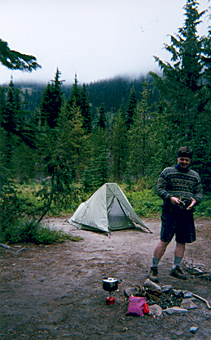Trip Planning and Day One
While I invited several friends to come along on this trip, only my old college roommate, Tim, had the time to come. We decided to leave in the middle of Labor Day weekend--the Sunday--and return to Seattle on Friday. Tim lives in Alaska and always brags about the wilderness in his state, but he "compromised" his standards for this trip. Tim took me on my first backpacking trip 21 years ago, but then pretty much gave up the hobby. I have been on about 15 trips since then, so our roles were reversed and I was the veteran in some respects.
The Goat Rocks Wilderness is located south of Mt. Rainier in the southern portion of the Washington Cascades. The 82,000-acre wilderness was first set aside in 1940. According to Fred Beckey's Cascade Alpine Guide, the area is "a complex of possibly as many as four overlapping volcanoes. Thick accumulations of fragmented material indicate a history of very explosive events. The Goat Rocks are a jumble of ragged spires resulting from violent volcanic action, followed by periods of rapid cooling."
It looked like a good place to test my new equipment and the idea of hiking longer sections of the Pacific Crest Trail. I thought we'd have to do a loop and hike back to our entry trailhead, but Tim was determined to take a straight shot northbound through the wilderness. He called L.E.W.I.S. Mountain Hwy Transit (1-800-994-8899) and arranged for the bus service to pick us up at White Pass and drive us to the entry trailhead at Walupt Lake, about 20 miles south of White Pass on logging roads. (It was expensive, costing more than $100, but hitching is impossible on logging roads.)
Sunday morning we left Seattle in damp weather, driving through Mt. Rainier National Park but not seeing the mountain due to the clouds and low ceiling. What kind of weather are we going to have for this trip, I wondered. Despite the rain and fog, we made it to White Pass in two and 1/2 hours--amazingly fast. The gas station/country store at the pass is a supply point for PCT through hikers and I met two while we were there waiting for the bus. The store owners showed us where to park, a place which happens to have a Web cam because it is the base of a ski hill and the high point of a highway pass through the Cascades.
Tim lost his patience while I was interviewing the through hikers (Jenny from Kirkland and a guy from Oakland wearing a Cal hat), and so eventually I broke off the conversation and parked the car. Tim was ready in a flash, but I took my time stowing away the last of my gear. Just as I was done, the Lewis Mountain Transit van showed up and whisked us away to Walupt Lake. Unfortunately, the logging road has a severe case of washboard and it took a long time to rumble up to the trailhead, which is in the midst of the Walupt Lake campground. But finally, at about 1 p.m., we were off.
The plan was to hike from Walupt Lake four miles to the junction with
the PCT. Then, if the weather was good, we might continue on to Sheep Lake.
If the weather was bad, we would camp near the junction. Along the trail
we saw lots of day hikers and horse parties, perhaps a foreshadowing for
the whole trip, we worried. When we started to hit some elevation, Tim slowed
down a bit. But my new pack felt fine and I was already happy that I had
decided to try the lightweight approach. We raced past some ponds near the
junction but looked up and saw that the ridge was shrouded with clouds.
Sheep Lake would be cold and foggy, if we could find it. We decided to camp
next to a marshy po nd instead of walking on.
nd instead of walking on.
It was a short hike of 4 miles, but good for breaking in the gear. I made a meal with marinated flank steak and fresh Asian noodles--indulgent but yummy. For water we had to use the pond--which meant that I had to treat my water with iodine tablets. I could tell that there was a serious drought. As the even grew dark, we heard elk bugling in the distance. Even Mr. Alaska had never heard that sound before and was impressed. Setting up the tent was fine, except that Tim is a large person and it would be a tight squeeze to rest comfortably in the tent the entire trip.
At left: Tim at our first campsite, with the Sierra Designs Clip Flashlight tent in the background.